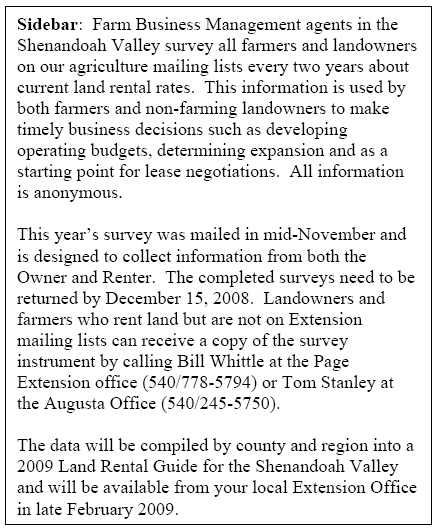
You've reached the Virginia Cooperative Extension Newsletter Archive. These files cover more than ten years of newsletters posted on our old website (through April/May 2009), and are provided for historical purposes only. As such, they may contain out-of-date references and broken links.
To see our latest newsletters and current information, visit our website at http://www.ext.vt.edu/news/.
Newsletter Archive index: http://sites.ext.vt.edu/newsletter-archive/

Leasing Agricultural Land in Uncertain Times
Farm Business Management Update, December 2008 - January 2009
By Bill Whittle (wwhittle@vt.edu), Extension Agent, Farm Business Management, Northwest District

Leasing farmland in the Shenandoah Valley is a valuable income source for farmers and landowners and also a land management tool for landowners. A new farmer can start on leased land with less expense and an established farmer can expand without a massive debt for land purchase. On the flipside, the landowner who does not want to or can no longer actively farm can receive some income and have the land maintained in a farmable condition. Discord can occur when one party believes the other is taking advantage, particularly in the rental rate. We are in challenging times where landowners are being pressed with higher expenses and they desire more income from their property. Landowners read about Midwest rental rates of $300-$400 per acre, and hear on the evening news that corn, soybeans and beef are at record prices. The landowner wants a piece of this action. On the other hand farmers have seen an extreme increase in the expenses necessary to grow a crop plus a commodity market that in the past six months has reached record highs for corn and soybeans but has fallen by 40%. The farmer feels he is being squeezed by everyone and cannot afford high rental rates for land.
This is a dilemma that requires both parties to understand the value of Valley property for farming and to negotiate a compromise compatible to each partyís objective. In most situations the issue will revolve around the cash payment with the landlord saying that what he receives doesnít cover the taxes and the tenant saying he canít make a decent income if he pays too high a rent. Both views are often true.
The question of how much should I charge/pay for land rent depends on the crop to be raised, the natural productivity of the land, improvements, and location.
An important issue that must be addressed is how to deal with the extreme volatility of agriculture markets. Extension recommends leases of three or more years so that both parties have stability. However, locking in rental rates in volatile times may be a recipe for discord. A tenant may pay a low rental rate for many years while earning strong income but when the lease finally renews the landlord will want an increase even if the agricultural markets and farm income is declining. As difficult and time consuming as it is to negotiate yearly rental rates as a component of a long-term lease, a regularly negotiated rate more closely reflects the current market conditions. Another tool is to base rental rates on agreed upon market prices during specific time frames. This is more complicated but can be more beneficial for both parties. Hopefully, the landlord would receive more money when prices are high and the tenant rental rate would be reduced when agriculture prices decline.


Visit Virginia Cooperative Extension